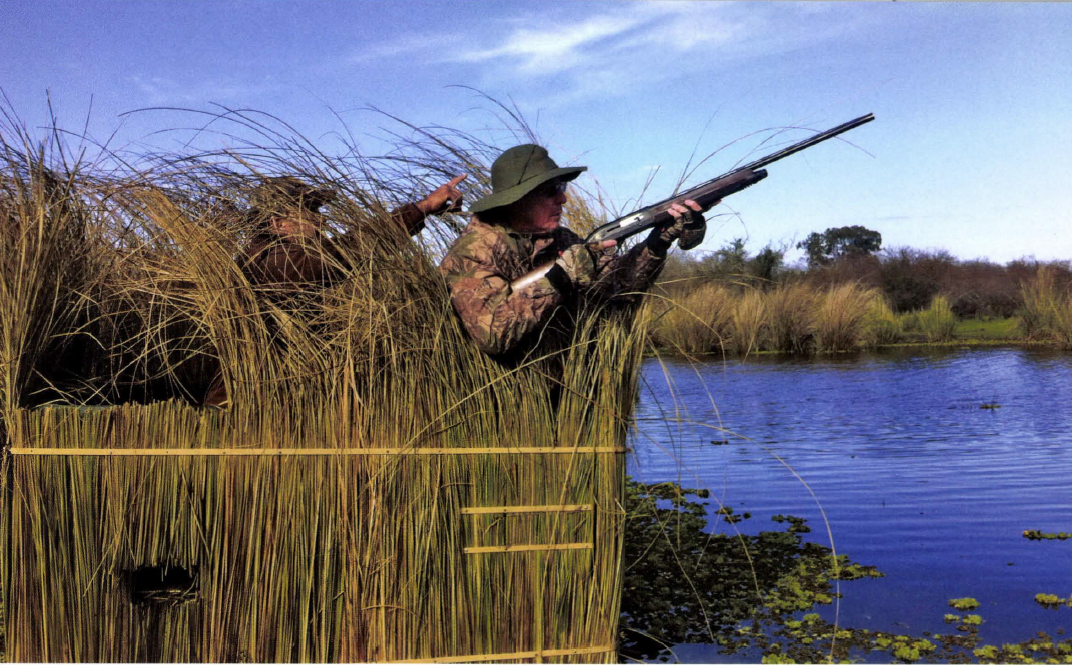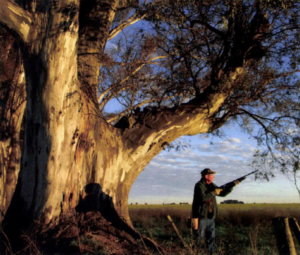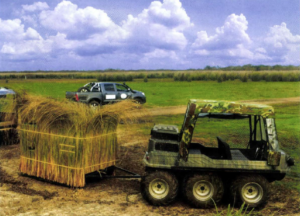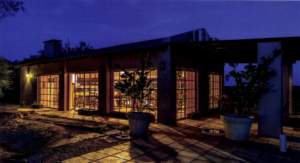Days of Wine and Roseys
April 29, 2020



 Hunting,SCA Articles
Hunting,SCA Articles

Superb wingshooting and fine dining are everyday events at this Argentina lodge.
Swiftly moving shapes materialized out of the darkness and passed in front of our blind. The temptation to shoot was strong in the half-light, but we just settled back and watched and listened, knowing the morning sun would bring dozens of flocks.
A sharp, cold wind blew from left to right, which meant that the ducks were approaching from right to left. Skip Hoagland and I were hunkered down in a modular blind with a wooden floor and bench that had been floated into position by a MAXX amphibious vehicle. Seated at opposite ends of the bench, Skip and I worked out a strategy: he would shoot at ducks in the front half of a flock and I would cover birds in the back end.
 At dawn, a big flock of rosybills spiraled into the decoys, their red beaks and orange eyes brilliant against the verdant Argentina countryside. We swung on the birds and the sky seemed to rain ducks. We each killed three – a double triple. Quickly we reloaded and got ready for the next flock.
At dawn, a big flock of rosybills spiraled into the decoys, their red beaks and orange eyes brilliant against the verdant Argentina countryside. We swung on the birds and the sky seemed to rain ducks. We each killed three – a double triple. Quickly we reloaded and got ready for the next flock.
Within minutes a pair of rosybill drakes passed in front, and we dumped both at the same instant. Then came a foursome, soon followed by a flock of at least 50 birds that crossed high overhead, then wheeled and descended toward the decoys. Four more roseys fell to our fusillade, followed by a spindrift of gray feathers that twisted idly in the wind and floated down onto the water, already sprinkled with dozens of spent shotgun shells.
The shooting continued hot for another hour, and before the morning came to an end, hundreds – if not thousands – of rosybills had passed over the marsh and we exulted at the sight. Finally, hunt master Hector de Bernardis, who was in a nearby blind taking video, waved for us to stop shooting, signaling the beginning of a sequence of events. Gauchos on horseback splashed through the water, pulling long pirogues for carrying our guns and ammunition, the decoys, and downed ducks. By the time they’d retrieved all the birds and loaded them on the horses, the animals’ bellies were dragging in the water.
We had been shooting rosy-billed pochards, one of the world’s most beautiful species of waterfowl. The rosybill comes in readily to decoys and loves to fly on sunny days. It also tends to fly long after sunrise, which gives visiting gunners a full morning of shooting.
The drake is a large bird with a bright red beak, a bulbous pink excrescence where the bill joins the head, orange eyes and feet and iridescent, purplish-green feathers on the head and neck. I rank it above the mallard for beauty and for its sporting qualities.
Back at Argentina Wingshooting Lodge we sat down to an exquisite luncheon that began with grilled potatoes covered in a Roquefort cheese sauce and more potatoes with a delicate mushroom sauce. We then moved on to the piece de resistance: a rosybill stew with a rich tomato-oregano sauce, with plenty of fine Rutini malbec-cabernet blend to wash it down. After that came a double-threat dessert – a rich chocolate cake and a fine cheesecake, with an excellent cortado (small strong coffee) to finish up.
Master host and lodge manager Gaston Piarrette, the “happiness maker,” busied himself by bringing on one course after another, decanting wine, sharing pleasantries, and making sure that everybody was pleased. Then we retired to our rooms for a siesta.
Afterwards it was “once more into the breech,” in the famous words of King Henry V, this time for perdiz over pointing dogs.
At the field, Hector put down two of his beautifully trained pointers. They had not gone a hundred yards before the front dog, an ivory-white English pointer, locked up as solid as a statue, while the other dog honored. Both dogs stepped forward a few paces, keeping pace with the perdiz as it scampered off through the grass. Finally, the pointers stopped and stood in a stately pas de deux, and the perdiz erupted almost from under Skip’s feet, rocketed away in a ground-skimming flight. Skip swung on it smoothly with his little Beretta 28 gauge over-and-under, and neatly laid it in the grass. By that time both dogs were on point again, and Hector encouraged Skip and me to move up quickly and put pressure on the bird. The perdiz is a running bird, much like a rooster pheasant, and will not fly unless the hunters and dogs keep close to put pressure on it. Otherwise, the bird will simply continue to run.
We knew the drill well and in a few minutes the perdiz got up with a roar, caught the wind in its wings, and swung around sharp to my left, where my shot train intercepted it in a great balloon of feathers. And so the action continued until we had a full bag of 15 birds.
Returning to the lodge we sat around the fireplace in the lounge for Happy Hour. Gaston busied himself by concocting pisco sours or margaritas or cappuccinos with a dollop of vanilla ice cream sprinkled with cinnamon, or whatever libations we might fancy. Skip, Hector, and I relaxed with our drinks while reposed on the huge couch facing the fireplace. Then Gaston brought in a huge platter of aperitivos, or appetizers, that included thick links of chorizo, or beef sausage; breasts of rosybill wrapped in bacon strips and seasoned with garlic salt and grilled to perfection over coals – truly a food fit for the gods – and provoleta, which is a slice of semi-melted provolone cheese smeared with olive oil and crushed oregano.
 Gaston announced that dinner was served, so we migrated to the dining room where wonderful aromas filled the room. There, an attractive blonde girl was turning a kid goat, or chivito, mounted on a spit over a bed of coals. Gaston lit candles on the dining table, and Skip cut off big chunks of the goat and served them all around. Dispensing with knives and forks, we tucked in our bibs and ate with our hands, sucking the bones to get every last morsel of the delectable meat. For 15 minutes there was no sound save the breaking of bones and the sucking of marrow.
Gaston announced that dinner was served, so we migrated to the dining room where wonderful aromas filled the room. There, an attractive blonde girl was turning a kid goat, or chivito, mounted on a spit over a bed of coals. Gaston lit candles on the dining table, and Skip cut off big chunks of the goat and served them all around. Dispensing with knives and forks, we tucked in our bibs and ate with our hands, sucking the bones to get every last morsel of the delectable meat. For 15 minutes there was no sound save the breaking of bones and the sucking of marrow.
In the meantime Gaston uncorked a bottle of a fine Salentein Reserva Pinot Noir 2012, and we drank a toast to our host and to a wonderful experience at his new lodge.
For dessert we enjoyed a terrific cheesecake, a fruit salad, and a slice of guava paste topped with a slice of mild cheese. Then Skip decanted glasses of Veuve Clicquot champagne – his favorite –and Gaston served up cafecitos, little cups of strong black coffee, to top off the feast. And so came to pass a typical day at Argentina Wingshooting Lodge.
The lodge is the brainchild and creation of Internet entrepreneur Skip Hoagland. For more than 30 years Skip hunted at many different Argentina lodges, but never found one that met his expectations. And so he decided to build his own.
He chose a location in the province of Entre Rios, where the flat alluvial plain is dotted with millions of acres of marshland and untold numbers of waterfowl. Unlike many other Argentine resorts that are totally dependent upon rainfall to provide adequate water levels for attracting and holding ducks, Skip’s marshlands will always have abundant water, because they’re fed by the Parana and Uruguay Rivers. All told, Skip controls the hunting rights to more than two million acres.
The lodge is also in close proximity to Buenos Aires, just a two-hour drive from the international airport. Newly arrived shooters can be at the lodge in time for lunch and a good afternoon shoot for doves or perdiz. None of those interminable drives far across the pampas to reach the lodge; no outrageously priced flights into the interior, with all the attendant complications of checking in guns or having your flight run late or even cancelled at the last minute. Remember, foreigners pay twice as much as Argentines for domestic flights.
Shooting for doves is excellent year-round but particularly in January and February when the lodge offers hunts at a much-reduced rate. There is a major dove roost only a half-hour’s drive from the lodge where you can easily fire a case of shells in a half day.
Pigeons are abundant during the harvest months of January through March. Argentina’s wild pigeon is about twice as big and much warier than city and barnyard pigeons in the United States. Hunters are often stationed close by a cattle feedlot where the birds come in waves to eat spilled corn. Pigeons are also gunned in the fields over carousels, such as those used in England and Scotland. Loaded with decoys or freshly killed birds, the carousel rotates round and round so the decoys simulate live birds coming in to feed. The shooters, who are concealed in camouflage net blinds, blast away endlessly. Both methods, if done right, can produce heavy bags of birds.
Argentine Wingshooting Lodge is a luxurious place, more of a resort than a shooting lodge. It has five large rooms, each furnished with a king-sized bed with orthopedic mattress, precise temperature control, marble countertops in the bathroom, and a state-of-the-art sound system. Just tell master host Gaston what time you want to wake up and your favorite kind of music. When I was there I awoke to the sound of Luciano Pavarotti singing O Sale Mia! and by Vivaldi’s Four Seasons. What a great way to start the day!
 The lodge has a flagstone deck with a fire pit where everyone gathers in the evenings to tell preposterous lies about their great shooting. In the lounge you can watch Fox News in the evenings and graze on big platters of aperitivos and swill ice-cold Quilmes beer. Soon there will also be a spa with masseuses and a fitness center and swimming pool.
The lodge has a flagstone deck with a fire pit where everyone gathers in the evenings to tell preposterous lies about their great shooting. In the lounge you can watch Fox News in the evenings and graze on big platters of aperitivos and swill ice-cold Quilmes beer. Soon there will also be a spa with masseuses and a fitness center and swimming pool.
The kitchen is equipped with state-of-the art cooking equipment, and food is prepared by top chefs on loan from the best restaurants in Gualeguaychu and Buenos Aires. This being Argentina, there is a heavy emphasis on the finest cuts of grass-fed beef: big slabs of thick, delectable bife de lomo (filet mignon) and bife de chorizo (New York strip steak), literally packed with wonderful flavor and tender enough to cut with a spoon. And how about mollejas, or sweetbreads, with a flavor even richer than the beef? There are huge, imaginative salads, and a well-stocked cellar with wines from the finest makers in the country – Rutini, Salentein, Andeluna, Caesar Catena, among others. And let us not forget those great desserts that the Argentines are masters of: tiramisu and flan and dulce de leche and Don Pedro, among others.
Skip Hoagland does not actively participate in the operation of the lodge. For all of the different functions he has hired experts, such as Hector de Bernardis, who is in charge of the hunting. A scion of a wealthy family, Hector has catered to demanding sportsmen from all over the world. His equipment is the best: Dodge Ram pickups, a fleet of MAXX amphibious vehicles, about 20 Beretta and Benelli and Franchi semi-automatic shotguns with cases and cases of ammunition, hundreds of decoys, and large quantities of camouflage materials for building blinds. He also has a dozen beautifully trained dogs for hunting perdiz.
Before the waterfowl season starts, Hector and his assistants construct about a hundred blinds in strategically situated places. He baits each blind heavily every other day, but shoots each blind only once a week so as not to drive the ducks away. Limits are exceedingly generous. Skip’s hunters take about 25,000 ducks a season, which is not a lot considering Argentina’s generous daily limits and that his vast marshland complex produces tens of thousands of waterfowl.
During February the nearby city of Gualeguaychu presents one of the great Carnival celebrations in the world. There are long parades of big floats loaded with beautiful girls in bikinis, dancing in the streets, and dining al fresco at many excellent restaurants. Gaston can organize visits to all these festivities. World-class dove shooting combined with a world-class Carnival celebration –certainly one of life’s great adventures. Don’t miss it!
